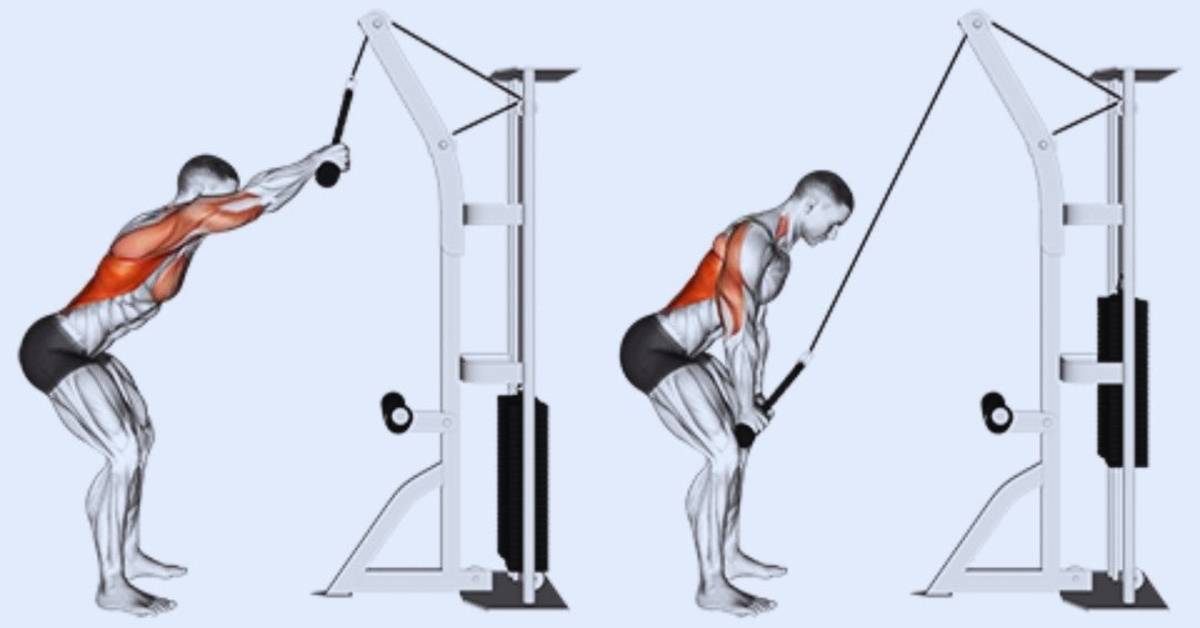The cable rope pullover is a popular exercise that targets several major muscles in the upper body. This exercise is commonly performed using a cable machine and a rope attachment, although it can also be done with a resistance band. In this blog post, we will discuss how to perform the cable rope pullover, the muscles worked, the benefits, and some alternative exercises that you can do to target the same muscles.
Cable Rope Pullover Muscles Worked
The cable rope pullover is a popular exercise that primarily targets the latissimus dorsi muscle, but it also works several other muscles in the upper body.
Latissimus Dorsi
The latissimus dorsi is the primary muscle worked during the rope pullover exercise. It is a large, fan-shaped muscle that runs down the side of the back and is responsible for several movements of the upper arm, including adduction, extension, and medial rotation.
During the exercise, the latissimus dorsi is responsible for pulling the arms down and back towards the hips. This movement places a strong emphasis on the lower portion of the muscle, which is responsible for the extension and adduction of the arm.
Teres Major and Minor
The teres major and minor muscles are located underneath the latissimus dorsi and are also worked during the exercise. These muscles are responsible for adduction, extension, and medial rotation of the upper arm.
During the cable rope pullover, the teres major and minor assist the latissimus dorsi in pulling the arms down and back towards the hips. Furthermore, they help stabilize the shoulder joint during exercise.
Triceps Brachii
On the back of the upper arm, there is a muscular group known as the triceps brachii, which consists of three heads. It is responsible for the extension of the elbow joint and contributes to the movement of the arms.
During the exercise, the triceps are responsible for extending the arms out in front of the body and maintaining tension in the muscle throughout the exercise. By doing this, the triceps develop strength and endurance.
Rhomboids
The rhomboids are a group of muscles located in the upper back that are responsible for the adduction and retraction of the scapula. During the rope cable pullover, the rhomboids help to stabilize the scapula and maintain proper posture.
Biceps Brachii
While the biceps brachii is not a primary muscle worked during the cable rope pullover, it does play a role in the movement of the arms. The biceps are responsible for flexion of the elbow joint and assist in pulling the rope down towards the hips.
Benefits of Rope Pullover Exercise
The cable rope pullover is an effective exercise that provides numerous benefits for the upper body. In this section, we will discuss the benefits of the cable rope pullover in detail.
Builds Upper Body Strength
The cable rope pullover is a compound exercise that works for multiple muscle groups in the upper body. By targeting the latissimus dorsi, teres major and minor, and triceps brachii muscles, this exercise helps to increase upper body strength and endurance.
Improves Posture
The exercise also helps to improve posture by strengthening the upper back muscles such as the rhomboids. These muscles are responsible for the adduction and retraction of the scapula, which helps to maintain proper posture and prevent slouching.
Enhances Athletic Performance
The cable rope pullover is an effective exercise for enhancing athletic performance, particularly for sports that require upper body strength and power. By targeting the latissimus dorsi and triceps brachii muscles, this exercise can improve throwing, hitting, and pushing movements.
Increases Flexibility
It is also helpful in increasing flexibility in the shoulders and upper back of an individual. The movement of the arms during the exercise stretches the shoulder joint and surrounding muscles, which can improve the range of motion and prevent injury.
Targets Hard-to-Reach Muscles
The cable rope pullover is particularly effective for targeting hard-to-reach muscles such as the lower portion of the latissimus dorsi. This muscle is often neglected in other exercises, but the rope cable pullover places a strong emphasis on this area.
Provides Versatility
The cable rope pullover can be performed in a variety of ways to target different muscles and achieve different goals. For example, a wider grip can place more emphasis on the outer portion of the latissimus dorsi, while a narrower grip can target the inner portion of the muscle.
How to do Cable Rope Pullover Perfectly?
Performing the cable rope pullover exercise with proper form is essential to effectively target the intended muscles and prevent injury. Follow these steps to perform the rope pullover exercise perfectly:
1. Adjust the Cable Machine: Ensure that the cable machine is adjusted to the correct height first. It should be set slightly above your head, and the rope should be attached to the pulley.
2. Choose Your Grip: When you grasp the rope, make sure that your hands are shoulder-width apart while using an overhand grip. Several different muscle groups can also be targeted by varying the grip you use.
3. Position Yourself: You need to stand with your feet shoulder-width apart, your knees slightly bent, and your feet facing away from the cable machine. Take a step forward with one foot, and brace your core to stabilize your body.
4. Start the Movement: Slowly pull the rope down and back behind your head, keeping your elbows straight and your arms parallel to the ground. Pause for a moment when the rope reaches the back of your head.
5. Return to Starting Position: Slowly release the rope back to the starting position, keeping your elbows straight and your arms parallel to the ground.
5. Repeat: Keep repeating the movement for as many repetitions as you wish.
Cable Rope Pullover Form Tips to Get Better Results
To get the most out of the exercise and avoid injury, it’s important to perform the exercise with proper form. Here are some tips to help you achieve better results with the cable rope pullover:
1. Keep your core tight: Throughout the exercise, make sure that your core muscles are engaged to stabilize your body and prevent excessive movement. A stable core will help you maintain proper form and effectively target the intended muscles.
2. Use a controlled movement: Avoid jerky movements and use a slow, controlled motion as you pull the rope down and back behind your head. In this way, you will be able to maintain proper form and prevent injuries from occurring.
3. Keep your elbows straight: As you pull the rope down and back, keep your elbows straight and your arms parallel to the ground. This will help you target the intended muscles, including the latissimus dorsi and triceps.
4. Don’t arch your back: Avoid arching your back as you pull the rope behind your head. This can put unnecessary stress on your spine and increase the risk of injury. Instead, maintain a neutral spine throughout the exercise.
5. Keep your shoulders down: When you are pulling the rope down and back, do not shrug your shoulders. This can cause tension in the neck and shoulders and prevent you from effectively targeting the intended muscles.
6. Use proper grip: Use an overhand grip with your hands shoulder-width apart on the rope. This will help you maintain proper form and effectively target the intended muscles.
7. Avoid hyperextending your shoulders: As you pull the rope down and back, avoid hyperextending your shoulders or pulling the rope too far behind your head. This can cause strain on the shoulder joint and increase the risk of injury.
8. Using too much weight: There is a risk of injury if you use too much weight. This can compromise your form. Start with light weights and gradually increase the resistance as you become stronger and more comfortable with the exercise.
Rope Cable Pullover Alternatives
If you’re looking for alternatives to the rope pullover exercise, several other exercises target similar muscles. Here are some alternatives to the cable rope pullover:
Dumbbell Pullover
The dumbbell pullover is a classic exercise that targets the lats and triceps.
To perform the exercise, lie down on a bench with a dumbbell in both hands. With your arms extended above your head, lower the dumbbell behind your head while keeping your elbows straight. Then, bring the weight back up to the starting position.
Straight-Arm Pulldown
The straight-arm pulldown is a variation of the cable rope pullover that targets the lats and triceps.
To perform the exercise, stand facing a cable machine with a rope attachment. With your arms straight and your core engaged, pull the rope down towards your thighs while keeping your elbows locked.
Lat Pulldown
The lat pulldown is a great exercise for targeting the lats and biceps.
To perform the exercise, sit at a lat pulldown machine with a wide grip attachment. With your arms extended above your head, pull the bar down towards your chest while keeping your elbows close to your body.
Cable Row Exercise
A cable row exercise is a compound exercise that targets muscles in the back of the body, specifically the lats, the rhomboids, and the trapezius.
To perform the exercise, sit on a rowing machine with your feet against the footrests and your knees slightly bent. With a straight back and engaged core, grasp the cable handles with an overhand grip and pull them towards your chest while keeping your elbows close to your body. Once you have reached the top of the movement, you should pause, then slowly release the cable handles to return the movement to where you started. The cable row exercise is an effective way to strengthen your back muscles and improve posture and can be easily modified to target different muscle groups.
Inverted Row
As a bodyweight exercise, the inverted row is a high-intensity exercise that targets the back muscles, as well as the biceps and forearms, which are both affected by this exercise.
To perform the exercise, set up a bar at hip height or use suspension straps attached to an anchor point. With your body in a straight line, grip the bar or straps with an overhand grip and walk your feet forward until your body is at an angle. At the top of the movement, squeeze your shoulder blades together and engage your core while pulling your chest towards the bar or handles by squeezing your shoulders together. Lower yourself back down with control to complete one repetition.
Related Posts: (humble row Exercise), (Lat Pushdown), (Chest Supported Dumbbell Row), (supinated barbell row)









